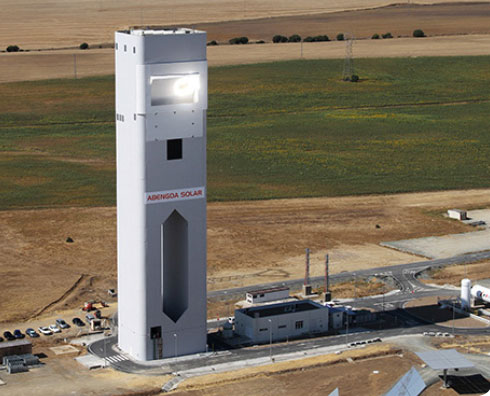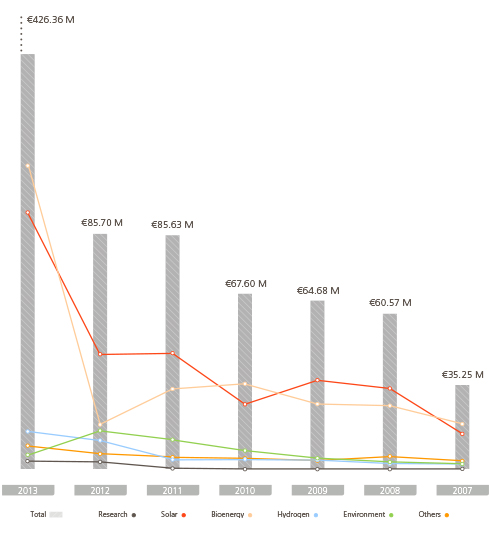 Abengoa
Abengoa
Annual Report 2013
- Activities
- Abengoa and innovation

Technological innovation: Source of sustainable development
The continuous growth of the world population, which is expected to reach 9 billion by the middle of this century , will mean a significant increase in the level of exploitation of resources such as water and fossil fuels as well as an increase in the creation of municipal and industrial waste. Environmental challenges posed by human activity, such as climate change , the exhaustion of resources and contamination of the biosphere, call for a change toward a more sustainable model.
To achieve sustainable growth implies tough technological challenges where Abengoa provides solutions through its R&D in the areas of energy and the environment.
In a bid to tackle the scarcity of water resources, Abengoa has developed technologies for the production of drinking water through desalination, potabilization and the reuse of industrial and household waters. This is made possible thanks to know-how and the development of different technologies based on improvements to operating conditions of filtration membranes, which are essential in order to achieve high levels of purity and quality in treated water.
Meeting these tough energy challenges head on, and considering that 80 % of the global energy system is based on fossil fuels, Abengoa offers solutions both for renewable electricity generation and for the substitution of fossil fuels for plant or organic fuels.
Since the 80s, Abengoa has been researching and developing technologies for the generation of electric energy from renewable sources. The development of solar power has made Abengoa a global driving force in the two main existing solar thermal technologies, namely the parabolic trough and tower systems. At the Solúcar Complex, the world’s largest mixed R&D center located in Seville (Spain), there is an ongoing demonstration of solar technologies, enabling us to be increasingly more efficient in order to achieve competitive costs with fossil fuels, such as Solugás, which is a concept that combines solar generation with a Brayton cycle using air as the heat transfer fluid, or DSG (direct steam generation) technology that permits the elimination of the intermediate heat transfer fluid in the solar field. Technologies, now commonplace on the market, have been demonstrated at this laboratory, such as the superheated steam tower technology, as applied at the Khi Solar One plant in South Africa or the TES (thermal storage system) in use at Solana, the world’s largest solar plant with 280 MW and 6 hours storage, making this technology manageable from a network point of view.

In the area of biofuels, in 2013 in Hugoton, Abengoa began operating a biorefinery with a production capacity of 95 ML of ethanol per year from 350,000 t of biomass. The technology used at this plant has been developed and tested by Abengoa over the last 10 years at the 2G demonstration plant located in Salamanca, Spain.
Abengoa is exploring the bio-refining concept with research in different processes to produce high value-added bioproducts from biomass. Thanks to R&D in this area, Abengoa will be able to produce n-butanol from biomass with the further advantage of being able to use the same facilities used for conventional biofuels. This means that the products of conventional plants are diversified while avoiding market volatility.
Another tough environmental challenge is the increase in municipal solid waste generated by densely populated urban areas together with stricter landfill laws. Abengoa, making use of its technological development in the area of biofuels, is researching the valorization of municipal solid waste (MSW). By combining hydrolysis- and fermentation-based treatments of organic matter found in waste for the production of ethanol and the recycling of materials for subsequent reuse, Abengoa will manage to significantly reduce the volume of landfill waste while lessening the reliance on petrol for the production of ethanol.
Abengoa’s technological development has been possible thanks to its continued commitment to R&D as the driving force behind growth. This is why Abengoa continues to invest in R&D and innovation. In 2013, Abengoa invested €426.36 M, representing approximately 5.8 % of its sales. This figure does not factor in investment in innovation, which, though not readily quantifiable, is a key element of Abengoa’s strategy.

Technology as the foundation for growth
Abengoa's business strategy and technology strategy nurture each other. The business strategy identifies new market needs and opportunities that require technological development, while the technology strategy provides the necessary know-how for the development of new products and services, reaching new markets. Thus, thanks to technology, Abengoa is able to boost its competitive advantage in its lines of business.
Technology is the driver of growth enabling Abengoa to offer more high-tech and competitive products and services. Research, development and innovation are conceived as the main source of competitiveness. These activities are geared towards the creation of competitive advantages that build barriers preventing the entry of the Abengoa's competitors, affording technological leadership in its products and services, and in the company's future businesses. The organization of R&D at Abengoa is headed by Abengoa Research together with the technology groups of the company's different areas. Abengoa Research is in charge of defining and managing the company's technology strategy, centralizing the research and development of all Abengoa's technologies, thus making good use of synergies and affording scientific and technical capabilities to all areas of activity in which the company operates.
In order to achieve the continued alignment the technology strategy with the business strategy, R&D&Innovation projects are under constant review through an efficient management system that uses systematic tools known and developed by all members of the organization. The main tools include:
-
TechValue: a tool that serves to evaluate the contribution of R&D towards the creation of competitive advantage by measuring the effects of R&D on cost reduction of Abengoa's products and services.
-
R&D Value: economic valuation of technological research and development, taking into account the markets and their progress, obtaining the value of each R&D program and the portfolio as a whole.
-
Stage-gate: tool for the management of R&D projects, where decisions are made in each phase on whether to continue, suspend or abandon projects.
This serves to improve the decision-making process through a portfolio of ongoing projects and with resources earmarked for the most attractive projects.
Nota 1 National Institute for Demographic Studies.
Nota 2 IPCC Fifth Assessment Report Climate Change 2013.
Solugas demonstration plant in Solucar platform, Seville.
Abengoa remains committed to R&D and innovation, ramping up its investment year after year.
© 2013 Abengoa. All rights reserved
